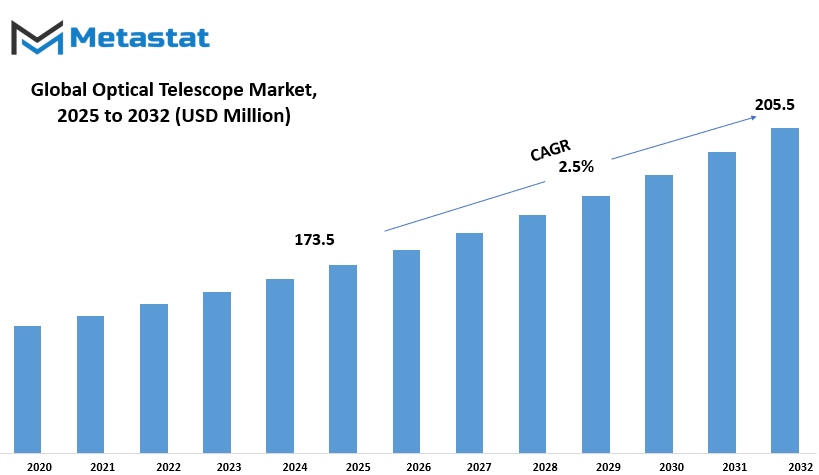MARKET OVERVIEW
The global optical telescope market will keep going beyond its roots and traditional applications in science, building its reach across new, unexpected industries and innovative uses. As the market develops, its application will be far beyond astronomy and space exploration. It is increasingly evident that the global optical telescope market will no longer be limited to a research or academic environment. Rather, it will find its way into new industries that require precision imaging, long-distance visual information, and technology integration.
Perhaps the global optical telescope will pass through the global optical telescope market. The most important trend is its convergence with artificial intelligence and machine vision. In a very distant future, sophisticated optical systems will be integrated into automated monitoring networks, environmental monitoring equipment and smart transport technologies. These techniques will give maximum levels of expansion and clarity, allowing for the decisions in real time and forecast reaction in complex settings. As urban centers become smarter and more networked, the power of optical telescopes to find fine details at great distances will be a resource not only to researchers but also to urban planners and security strategists.
The entertainment and media sectors are also likely to discover new uses for optical telescope technologies. From recording remote vistas for ultra-high-definition content to augmenting virtual reality with imagery of the real world, these tools will serve to close the loop between visual reality and digital immersion. Production houses and filmmakers can turn to telescopic imaging to create scenes that would otherwise mean expensive drone operations or satellite material. The application can transform the way visual content is created, particularly in high-budget movies and immersive games.
Medical imaging can also experience slight but significant alterations driven by technologies sourced in the global optical telescope market. The ability of telescopes to provide distinct, high-magnification imaging will be used to improve endoscopic and diagnostic equipment. Although not exactly similar in purpose, the common methodology of light control and lens accuracy implies that spillover from the two fields will result in improved accuracy and minimally invasive surgeries in the future.
Aside from terrestrial applications, private satellite communications and aerospace companies will depend increasingly on optical telescope innovations. With nations and businesses continuing to send satellites into orbit for communication, Earth observation, and scientific research purposes, ground-based optical tracking systems will become more in demand. Optical tracking systems will be responsible for keeping tabs on satellite health, orbit, and space debris engagements. As commercialization of space picks up speed, optical telescope systems will potentially become one of the essential tools for long-term orbital infrastructure sustainability.
The global optical telescope market will also become an input into the study of environmental science, helping to track climate, monitor oceans, and monitor wildlife from distant perspectives. High-resolution, long-range imaging ability will enable scientists to examine otherwise out-of-reach areas. Subsequent monitoring will then input into conservation efforts and ecosystem management strategies going forward.
In short, though the global optical telescope market has hitherto been linked to the observation of celestial bodies, its path will take it to varied horizons, changing the way different industries perceive and interpret their environment. This market will not just grow in volume but will redefine itself through adjustment, unification, and continued need for visual accuracy.
Global optical telescope market is estimated to reach $205.5 Million by 2032; growing at a CAGR of 2.5% from 2025 to 2032.

GROWTH FACTORS
The global optical telescope market will experience a significant change in the years to come with increasing interest in space and astronomy. As more people fall in love with celestial occurrences and the secrets and techniques in space, demand for optical telescopes is increasing. This includes each scientists and novice astronomers who wish to view the celebrities and planets. The trend is also superior by augmented public focus, academic outreach, and expanding on-line groups sharing astronomical content material. Consequently, individuals throughout age organizations and backgrounds are more and more willing to invest in telescopes for his or her non-public use.
Simultaneously, ongoing enhancements in optical era are enhancing telescope performance. Manufacturers are growing telescopes with progressed photo readability, broader field of view, and less difficult-to-use capabilities. These advancements now not best make telescopes greater efficient but also less complicated to apply for folks that do no longer always have an engineer's technical acumen. Advances which include automatic mounts, phone functionality, and greater lens coatings are making it less difficult than ever for users to find and look at celestial objects. This technological advancement will probable encourage extra human beings to take a look at astronomy, so that you can in flip cater to the global optical telescope boom.
But there are a few challenges that can abate this development. One of the most important challenges is the fee of superior telescopes. Although professional-grade devices offer higher overall performance, additionally they tend to be out of reach for novice astronomers. This restricts the global optical telescope market to a smaller target market of nicely-heeled customers, except a massive ability market this is involved however now not in the mood for significant expenditure. A 2d problem is town light pollution, that could have a dramatic impact at the skills of floor-primarily based telescopes.
In spite of these difficulties, the future is bright. The creation of less expensive and portable telescopes can appeal to a wider consumer market. By making them affordable and portable, manufacturers are able to appeal to students, families, and amateur users who want to view the night sky without an enormous financial or technical investment. If businesses set their targets in balancing cost and performance, the market will extend to encompass more first-time consumers and schools. The market will be more dynamic and inclusive through these initiatives in the next couple of years.
MARKET SEGMENTATION
By Type
The global optical telescope market will keep to shift as innovation and hobby in space remark develop regularly across both beginner and expert sectors. While medical groups and studies institutes remain key drivers, the growing number of hobbyists and academic programs using telescopes will substantially impact demand within the years yet to come. Optical telescopes are crucial gear for viewing remote celestial our bodies, and their growing affordability has made them greater handy than ever earlier than. As hobby in astronomy deepens, specially via instructional outreach and social media awareness, the want for diverse styles of optical telescopes will grow. Manufacturers will respond to this demand by using enhancing features and making them greater consumer-friendly with out compromising precision.
The global optical telescope market is segmented by using type, with every category serving distinctive person needs and technical possibilities. The refracting telescope segment, worth $88.9 million, will preserve a strong function, in particular due to its recognition amongst beginners and educational establishments. These telescopes use lenses to gather mild and form snap shots, making them simpler to address and preserve. Their simplicity, paired with a durable design, makes them best for faculties, faculties, and access-stage astronomers who are trying to find clean perspectives of the moon, planets, and stars.
Reflector telescopes, on the other hand, will cater more to experienced users. These telescopes rely upon mirrors instead of lenses, imparting greater aperture sizes and deeper sky viewing competencies. They are favored by way of individuals who want to observe galaxies, nebulae, and remote objects that require better light-gathering energy. Although they demand more maintenance and alignment, their performance will attract serious astronomers and research laboratories.
Catadioptric binoculars, which combine both lens and mirrors, will see growing interest from a broader category of users. These hybrid systems provide advantages of compactness and versatility. Their ability to reduce optical deformities by maintaining portable design makes them suitable for terrestrial and astronomical viewing. Professional and enthusiastic will equally adopt these models for their flexibility and balanced features.
The global optical telescope market will remain strong as interested in space, as interested in educational campaigns, science-based entertainment and potential commercial space travel. Product development image will focus on improving clarity, reducing weight and integrating digital tools such as tracking systems and smartphone compatibility. The growth of the market will not only depend on scientific needs, but will also depend on the fact that manufacturers can easily connect with the growing communities of sky-looking.
By Application
The global optical telescope market is slowly charting its course depending on the manner in which varied applications continue to define its course. Amateur astronomy is one of the main uses of optical telescopes, particularly among enthusiasts and hobbyists who are using the night sky for their own interest. These tend to be entry-level telescopes that are both inexpensive, simple, and meant to familiarize users with basic observation of the stars. The global optical telescope market will increase as more individuals seek fulfilling recreational pursuits or engage in astronomy as a hobby. The accessibility of online tutorials and astronomy clubs has further supported this community, providing them with the tools and confidence to enjoy stargazing and simple sky tracking.
At the opposite end of the global optical telescope market, professional research will continue to be a robust application area. This category consists of sophisticated astronomical telescopes employed by observatories, universities, and scientific institutions. These telescopes will aid in further space exploration, assist in the identification of new celestial bodies, and aid in several research operations in astrophysics. As technology advances, telescopes in this category are supposed to provide even more accurate data, particularly through computer-controlled systems, improved optics, and image processing software. Although such instruments are costly, institutions will continue to depend on them to facilitate long-term research and international cooperation in the field of space science.
There exists increasingly a middle segment in the global optical telescope market that lies between amateur and professional usage. Frequently lumped with "Others," this category consists of intermediate-level telescopes utilized by educators, advanced hobbyists, and semi-professional scientists. These models provide more functions than entry-level models and act as a stepping stone for individuals who wish to move beyond their interest or prep themselves for more serious study in astronomy. Private schools, private schools, and community observatories will be inclined to purchase this level of equipment to facilitate learning and public outreach events.
As interest in astronomy and space continues to expand among various user communities, ranging from amateur stargazers to veteran researchers, the market for optical telescopes in every category will change. Firms will have to keep striking a balance between innovation and affordability, ensuring that high-end features are both accessible to top professionals and the general public interested in the universe. This method will maintain the global optical telescope market and tied to shifting interests while aligning both education and exploration objectives.
|
Forecast Period |
2025-2032 |
|
Market Size in 2025 |
$173.5 million |
|
Market Size by 2032 |
$205.5 Million |
|
Growth Rate from 2025 to 2032 |
2.5% |
|
Base Year |
2024 |
|
Regions Covered |
North America, Europe, Asia-Pacific, South America, Middle East & Africa |
.
REGIONAL ANALYSIS
The global optical telescope market will maintain to reflect a dynamic geographical distribution, fashioned by using various regional demands, improvements in generation, and academic investments. North America, being one of the greater advanced areas, will preserve its regular hold on the global optical telescope market, in large part pushed by the U.S. The United States will play a main position, supported by substantial research projects, astronomical observatories, and regular public and personal investment. Canada and Mexico may even contribute to the place’s proportion, with developing interest in both educational and newbie astronomy fueling product call for throughout institutions and client segments.
In Europe, countries including the UK, Germany, France, and Italy will maintain a robust global optical telescope market presence. These international locations have a long-status way of life in scientific exploration and area statement, with a view to inspire regular adoption of optical telescopes. Institutions across the place will invest in telescope enhancements and new installations, with educational and studies packages being the primary driving pressure. The Rest of Europe will display slower boom but nevertheless gain from regional collaborations and EU-degree technological know-how funding in order to hold the market moving ahead.
Asia-Pacific may be a major location of focus for future boom. Countries like China, India, Japan, and South Korea will push ahead with increasing area packages and increasing academic investments. China’s space tasks and India’s growing interest in astronomical sciences will create extra possibilities for telescope manufacturing and deployment. Japan and South Korea will also make contributions to the area’s growing call for through advanced technologies and collaborations with international institutions.
South America will show the promising movement under the leadership of Brazil and Argentina. These nations will probably look at the demanded demand from universities and research institutes, and gradually the equipment becomes more accessible as equipment from amateur stargers. Although economic factors can affect immediate growth, increasing public interests in science and technology will support the gradual increase in the use of telescopes. The rest of South America will experience similar trends, although on a small scale.
The Middle East and Africa will present a mixed photo. GCC countries such as UAE and Saudi Arabia are investing in science and technology projects, including space -related initiatives that will affect the purchase of binoculars. Egypt and South Africa will also show remarkable activity, especially through educational institutions and astronomy clubs. The remaining countries of the region will grow at a slow pace, which are the size of different levels of economic growth and infrastructure.

COMPETITIVE PLAYERS
The global optical telescope market will not only look at the changes of technology, but will also be of how people continue to detect and understand beyond the world. Optical binoculars are devices that use lenses or mirrors to observe distant objects, usually in astronomy. He has played a role in helping both professionals and enthusiasts look deeply into space. As the interest in astronomy is increasing between enthusiasts and institutions, the demand for quality telescopes will increase. People are now looking for devices that give them more detail, sharp images and better clarity. It will push shift manufacturers to bring forward the models that are easy to use, portable and suitable for many purposes - whether it is to see the sky, astronomy, or educational use.
Companies such as Selesteron, Meaday and Wicksen Optics will continue to shape this place through product innovation. Other companies such as Takahashi, Bushnell, Orion and Bracer, will focus on offering more accurate equipment with better optical quality. Brands such as Sharpstar, QHyCCD, and Askar Telescope are also finding their place by catering for users who seek advanced imaging abilities. The global optical telescope market will also pay attention to the entry -level models from brands such as visioning and Barska that are becoming popular among beginners.
With hardware, software integration will also play a role. Optical telescopes will be expected to come up with support apps or digital tools that help users easily navigate the night sky. This will move towards better clever functionality will attract a new audience that is comfortable using technology. At the same time, educational institutions and space agencies will continue to invest in high-end telescopes for training and research objectives. As a result, major players like Astro-Picix and Aperture Telescope will maintain a strong appearance through their special offerings.
Makes the global optical telescope market unique, it is shared curiosity that it taps - the desire to find and learn. From school children to observatories, the use of telescopes will continue to expand. People will continue to invest in devices that bring closer distant sky, and mentioned companies will be central to shaping experiences. The global optical telescope market will not only increase; It will develop in a direction that reflects human attraction with space and equipment used to understand it.
Optical Telescope Market Key Segments:
By Type
- Refracting Telescope
- Reflector Telescope
- Catadioptric Telescope
By Application
- Amateur Astronomy Hobby (Enter-Level Telescope)
- Professional Research (Advanced Astronomical Telescope)
- Others (Intermediate Level)
Key Global Optical Telescope Industry Players
- Celestron
- Meade
- Vixen Optics
- TAKAHASHI
- ASTRO-PHYSICS
- Bushnell
- Bresser
- ORION
- Barska
- Sky Watcher
- Bosma
- SharpStar
- Visionking
- QHYCCD
- Aperture Telescopes
- Optolong
- Askar Telescopes
WHAT REPORT PROVIDES
- Full in-depth analysis of the parent Industry
- Important changes in market and its dynamics
- Segmentation details of the market
- Former, on-going, and projected market analysis in terms of volume and value
- Assessment of niche industry developments
- Market share analysis
- Key strategies of major players
- Emerging segments and regional growth potential








 US: +1 3023308252
US: +1 3023308252






